
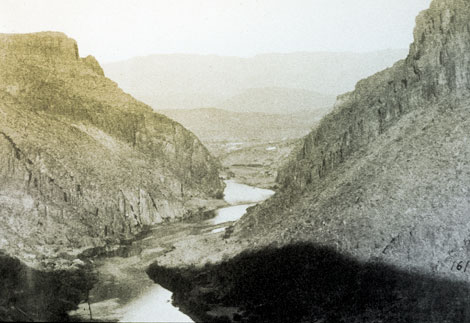 View up the Salt River Canyon below the site selected for Roosevelt Dam, 1904. The dam site was identified as early as 1889 by surveyors. (Reclamation photograph)
View up the Salt River Canyon below the site selected for Roosevelt Dam, 1904. The dam site was identified as early as 1889 by surveyors. (Reclamation photograph)
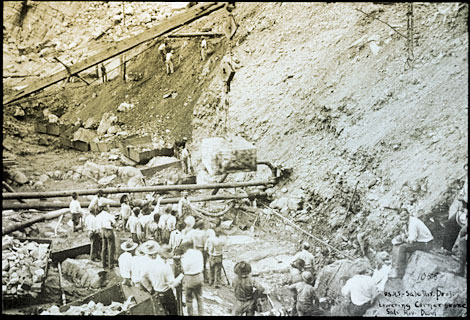 The cornerstone for Roosevelt Dam was laid September 20, 1906. (Reclamation photograph)
The cornerstone for Roosevelt Dam was laid September 20, 1906. (Reclamation photograph)
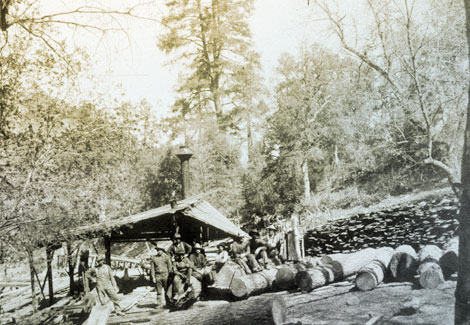 As construction got underway, the Reclamation Service established a lumber mill in the Sierra Ancha Mountains north of the Roosevelt Dam site. A local source for construction lumber was less expensive than hauling it from Mesa, 1904. (Reclamation photograph)
As construction got underway, the Reclamation Service established a lumber mill in the Sierra Ancha Mountains north of the Roosevelt Dam site. A local source for construction lumber was less expensive than hauling it from Mesa, 1904. (Reclamation photograph)
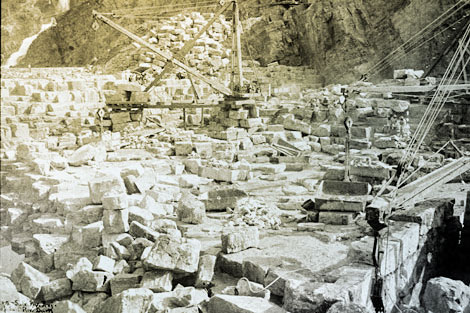 By 1907, construction of the Roosevelt Dam was well underway. (Reclamation photograph)
By 1907, construction of the Roosevelt Dam was well underway. (Reclamation photograph)
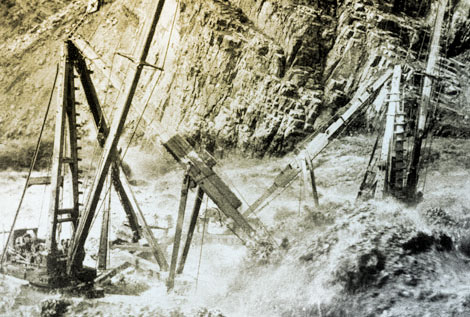 Flooding was a serious threat during Roosevelt Dam construction, 1908. (Reclamation photograph)
Flooding was a serious threat during Roosevelt Dam construction, 1908. (Reclamation photograph)
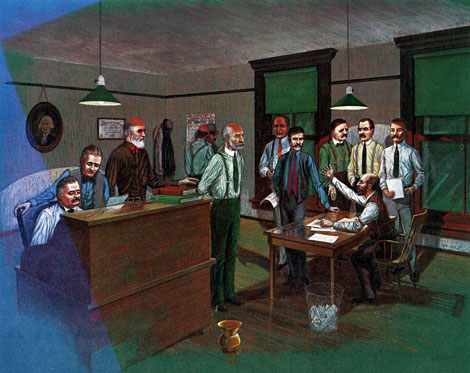 Salt River Valley Users Association Meeting as painted by C. Kemper, 1980. L to R: J.kibbey, P.T. Hurley, W. Christy, H. Simkins, W. Wallace, B.A. Fowler, A.J. Chandler, F. Parker, L. Orme, D. Heard, F. Alkire (seated), G. Maxwell. (Courtesy of Salt River Project)
Salt River Valley Users Association Meeting as painted by C. Kemper, 1980. L to R: J.kibbey, P.T. Hurley, W. Christy, H. Simkins, W. Wallace, B.A. Fowler, A.J. Chandler, F. Parker, L. Orme, D. Heard, F. Alkire (seated), G. Maxwell. (Courtesy of Salt River Project)
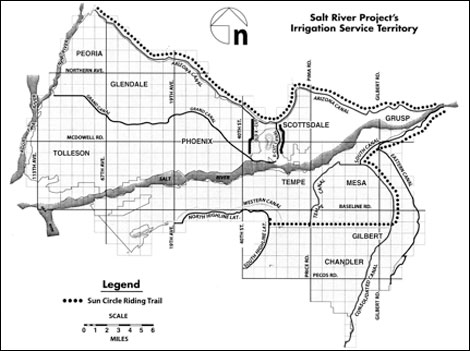 SRP Canals, Courtesy of Salt River Project
SRP Canals, Courtesy of Salt River Project
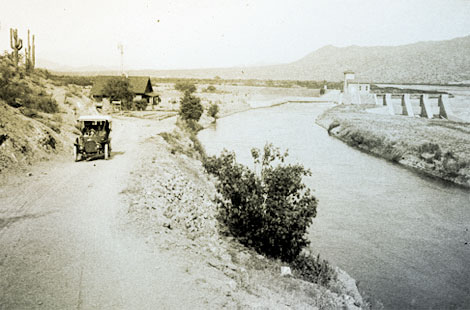 Granite Reef Diversion Dam with outlet for the Arizona Canal around 1910. (Reclamation photograph)
Granite Reef Diversion Dam with outlet for the Arizona Canal around 1910. (Reclamation photograph)
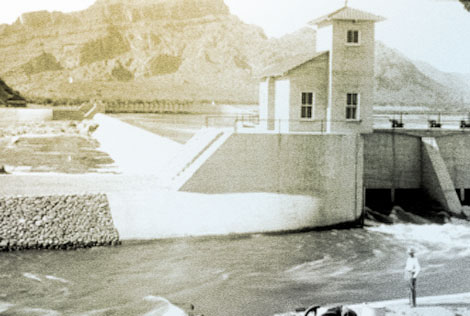 Granite Reef Diversion replaced the crude rock and brush dams that washed out in floods, providing a reliable structure to divert water into the Arizona and South canal, 1910. (Reclamation photograph)
Granite Reef Diversion replaced the crude rock and brush dams that washed out in floods, providing a reliable structure to divert water into the Arizona and South canal, 1910. (Reclamation photograph)
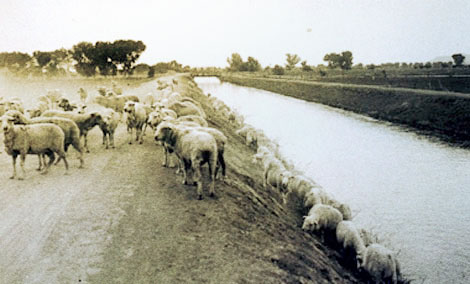 Canal maintenance was an on-going problem, and Government sheep were used to control weeds and grass along the canals, 1914. (Reclamation photograph)
Canal maintenance was an on-going problem, and Government sheep were used to control weeds and grass along the canals, 1914. (Reclamation photograph)
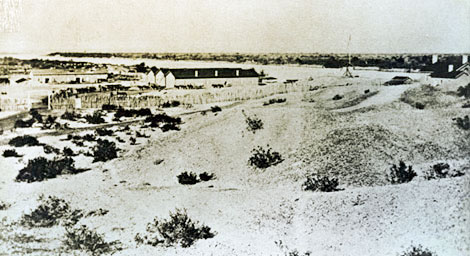 In 1864, the U.S. Army established the Yuma Quartermaster Depot on the Arizona side of the Colorado River where a six-month supply of goods was kept at all times. This is the earliest and one of few photographs of the depot taken before 1871. (Reclamation photograph)
In 1864, the U.S. Army established the Yuma Quartermaster Depot on the Arizona side of the Colorado River where a six-month supply of goods was kept at all times. This is the earliest and one of few photographs of the depot taken before 1871. (Reclamation photograph)
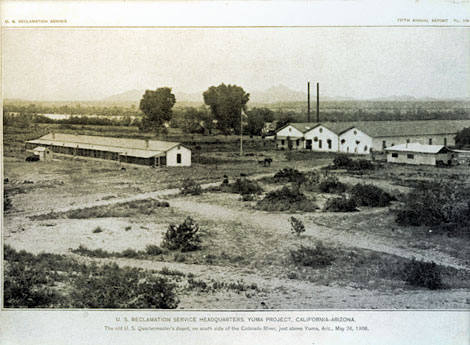 U.S. Reclamation Service headquarters, Yuma Project, located at the former Fort Yuma U.S. Army Quartermaster Depot and Yuma Crossing. (Yuma Projects Office Fifth Annual Report, May 26, 1906)
U.S. Reclamation Service headquarters, Yuma Project, located at the former Fort Yuma U.S. Army Quartermaster Depot and Yuma Crossing. (Yuma Projects Office Fifth Annual Report, May 26, 1906)
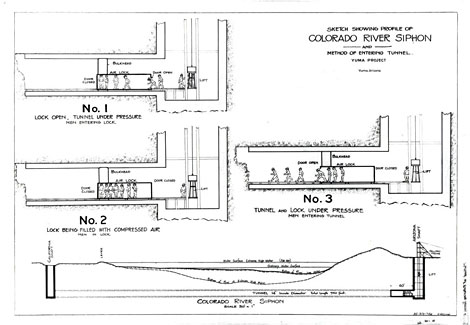 Sketch of the Colorado River Siphon. (National Archives, Yuma Projects Office, No date)
Sketch of the Colorado River Siphon. (National Archives, Yuma Projects Office, No date)
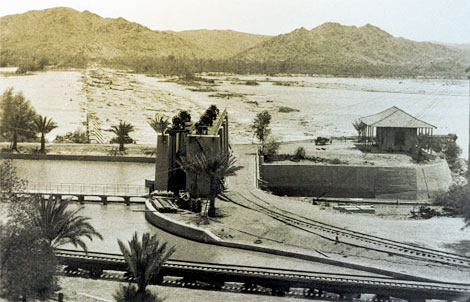 View of Laguna Dam showing the desilting basin, sluice gates, and Yuma Canal regulating gates. (National Archives, Yuma Projects Office, No date)
View of Laguna Dam showing the desilting basin, sluice gates, and Yuma Canal regulating gates. (National Archives, Yuma Projects Office, No date)
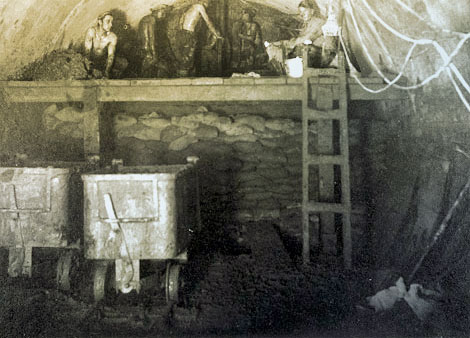 Sand hogs at work on the heading of the Colorado River Siphon tunnel underneath the Colorado River. A "sand hog" is a slang term for construction workers who work underground on a variety of construction projects. A bulkhead of sandbags was built at the end lower of the tunnel while excavation continue in the upper half of the tunnel. The sandbags prevented water from seeping in on the sand hogs while the arch was being drilled, 1912. (National Archives, Yuma Project Office)
Sand hogs at work on the heading of the Colorado River Siphon tunnel underneath the Colorado River. A "sand hog" is a slang term for construction workers who work underground on a variety of construction projects. A bulkhead of sandbags was built at the end lower of the tunnel while excavation continue in the upper half of the tunnel. The sandbags prevented water from seeping in on the sand hogs while the arch was being drilled, 1912. (National Archives, Yuma Project Office)
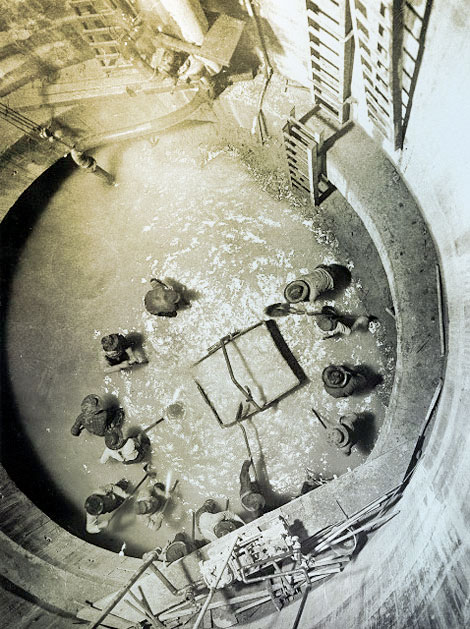 Colorado River Siphon. Looking down 55 feet into the Arizona shaft during the night shift, 1910. (National Archives, Yuma Projects Office)
Colorado River Siphon. Looking down 55 feet into the Arizona shaft during the night shift, 1910. (National Archives, Yuma Projects Office)
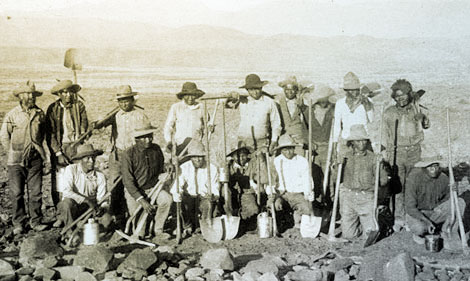 American Indian laborers were hired by Reclamation Service Chief Engineer Lewis Hill. San Carlos and other Western Apache tribes supplied the bulk of the work force for Roosevelt Dam road construction and other infrastructure needs, 1906. (Reclamation photograph)
American Indian laborers were hired by Reclamation Service Chief Engineer Lewis Hill. San Carlos and other Western Apache tribes supplied the bulk of the work force for Roosevelt Dam road construction and other infrastructure needs, 1906. (Reclamation photograph)
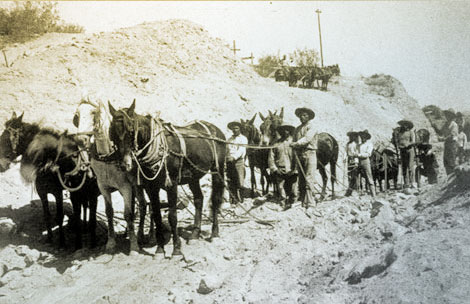 Apache workers on the cutoff canal, Roosevelt Dam site, 1909. (Reclamation photograph)
Apache workers on the cutoff canal, Roosevelt Dam site, 1909. (Reclamation photograph)
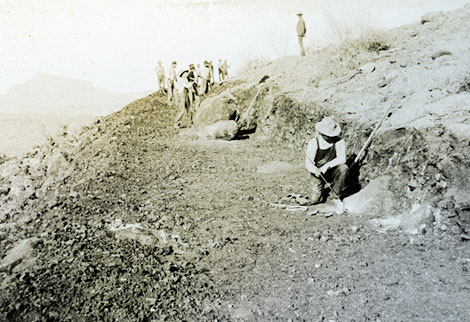 Apache road crew working on the road between Globe and Roosevelt, 1904. (Reclamation photograph)
Apache road crew working on the road between Globe and Roosevelt, 1904. (Reclamation photograph)
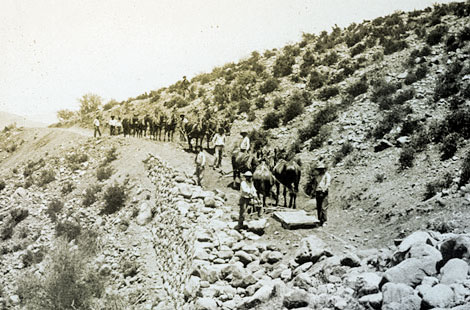 Apache teamsters placing fill on the new Tonto Highline Road. Note the dry-laid masonry retaining wall. (Reclamation photograph)
Apache teamsters placing fill on the new Tonto Highline Road. Note the dry-laid masonry retaining wall. (Reclamation photograph)
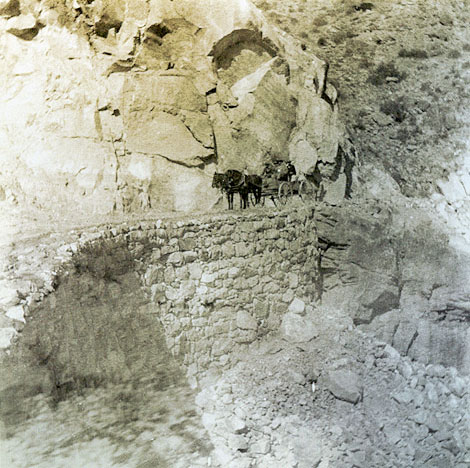 Apache workers were known for their skill in building dry-laid stone walls. Without using mortar, they constructed many such retaining walls along the various roads they built. This fine example is on Fish Creek Hill on the Mesa to Roosevelt Road, known today as the Apache Trail, 1905. (Courtesy of Salt River Project)
Apache workers were known for their skill in building dry-laid stone walls. Without using mortar, they constructed many such retaining walls along the various roads they built. This fine example is on Fish Creek Hill on the Mesa to Roosevelt Road, known today as the Apache Trail, 1905. (Courtesy of Salt River Project)
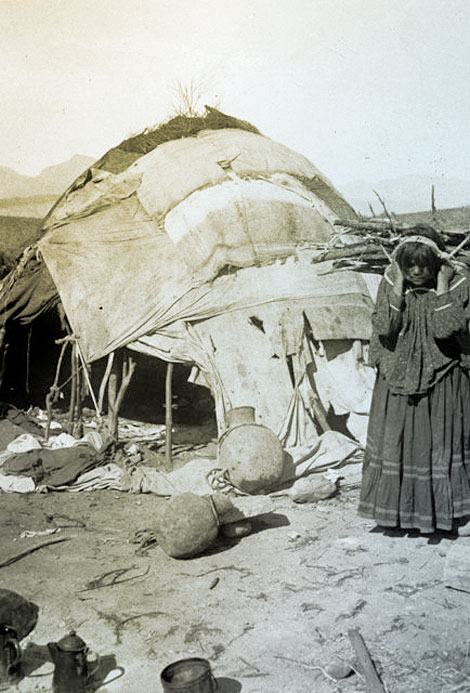 Apache workers often brought their families to live with them. They lived in a segregated area and maintained their traditional lifestyle. Here an Apache woman brings firewood to her wickiup, a structure of bent poles covered with brush that is also covered with blankets, tarps, and hides. Note the use of large ceramic storage jars and metal pots and pans, 1911. (Reclamation photograph)
Apache workers often brought their families to live with them. They lived in a segregated area and maintained their traditional lifestyle. Here an Apache woman brings firewood to her wickiup, a structure of bent poles covered with brush that is also covered with blankets, tarps, and hides. Note the use of large ceramic storage jars and metal pots and pans, 1911. (Reclamation photograph)
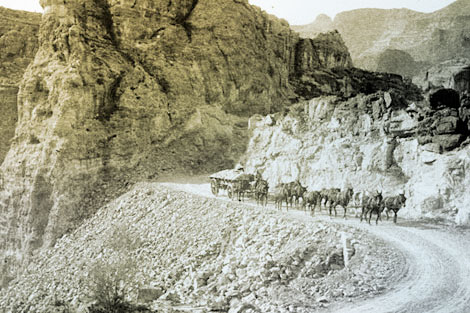 A portion of Mesa to Roosevelt Road at Fish Creek Hill. Note the extensive road work required to cut through the mountain and provide fill for a stable road bed. American Indians, primarily Apaches, constructed over 100 miles of roads to provide access for men, equipment, and supplies to the dam site, 1905. (Reclamation photograph)
A portion of Mesa to Roosevelt Road at Fish Creek Hill. Note the extensive road work required to cut through the mountain and provide fill for a stable road bed. American Indians, primarily Apaches, constructed over 100 miles of roads to provide access for men, equipment, and supplies to the dam site, 1905. (Reclamation photograph)
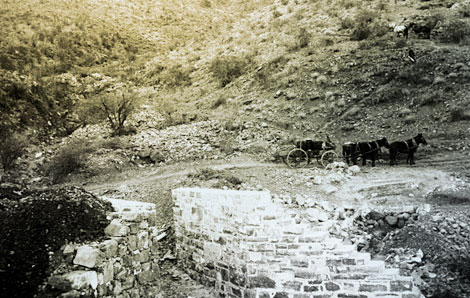 Wagon on road between Mesa and the Roosevelt Dam site, 1904. (Reclamation photograph)
Wagon on road between Mesa and the Roosevelt Dam site, 1904. (Reclamation photograph)
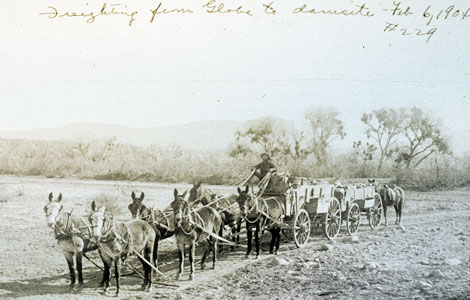 Freight wagons with mule team bringing supplies to the Roosevelt Dam site on the road from Globe, 1904. (Reclamation photograph)
Freight wagons with mule team bringing supplies to the Roosevelt Dam site on the road from Globe, 1904. (Reclamation photograph)
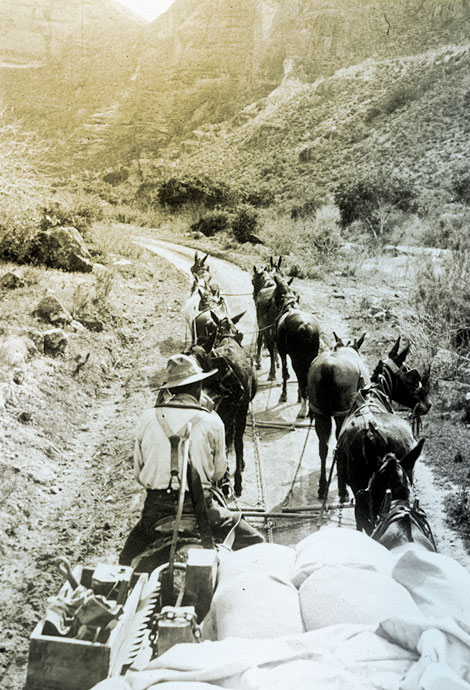 Government freight wagon at foot of Fish Creek Hill on way to dam site, 1907. (Reclamation photograph)
Government freight wagon at foot of Fish Creek Hill on way to dam site, 1907. (Reclamation photograph)
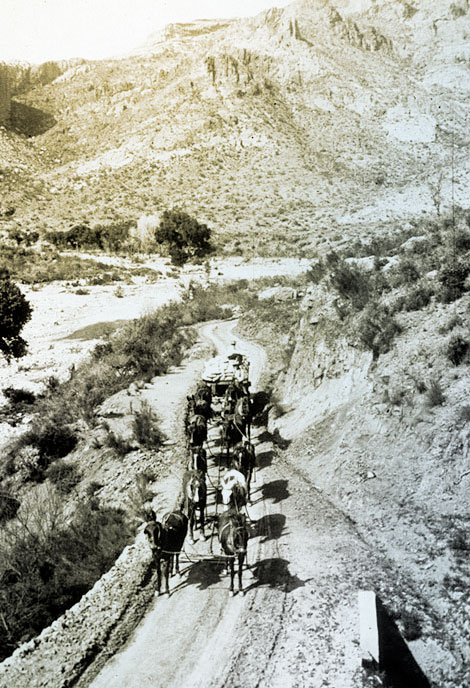 Government freight wagon (previous picture) entering Fish Creek Station, 1907. (Reclamation photograph)
Government freight wagon (previous picture) entering Fish Creek Station, 1907. (Reclamation photograph)
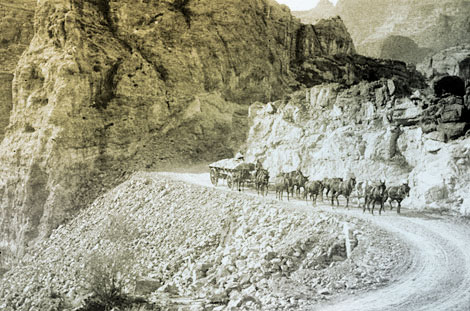 Government freight wagon coming up Fish Creek Hill, 1907. (Reclamation photograph)
Government freight wagon coming up Fish Creek Hill, 1907. (Reclamation photograph)
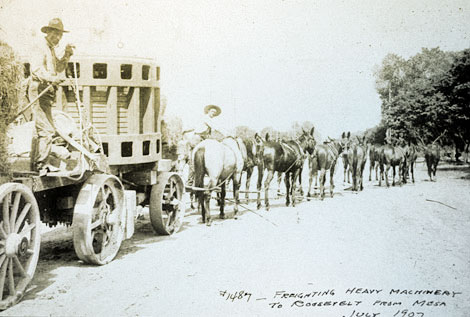 Freight wagon with generator headed for Roosevelt Dam from Mesa, 1907. (Reclamation photograph)
Freight wagon with generator headed for Roosevelt Dam from Mesa, 1907. (Reclamation photograph)
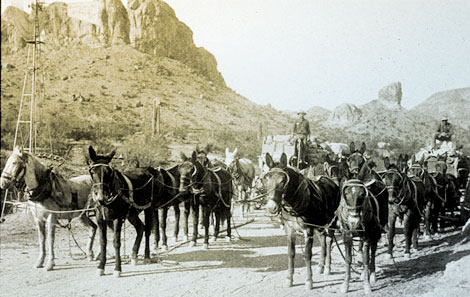 Freight wagon teams at Government Wells on way to Roosevelt Dam, 1907. (Reclamation photograph)
Freight wagon teams at Government Wells on way to Roosevelt Dam, 1907. (Reclamation photograph)
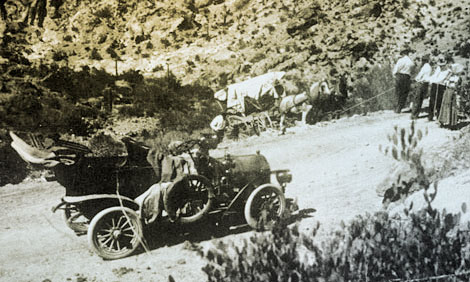 Assisting stage coach on Roosevelt Road, 1910. (Reclamation photograph)
Assisting stage coach on Roosevelt Road, 1910. (Reclamation photograph)
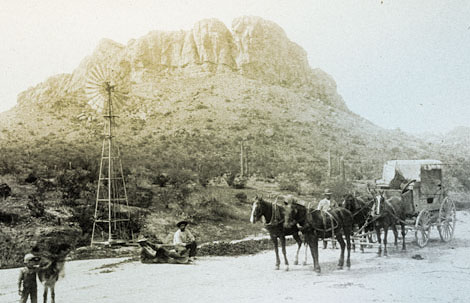 Wagon and horses at Government Wells, n.d. (Reclamation photograph)
Wagon and horses at Government Wells, n.d. (Reclamation photograph)
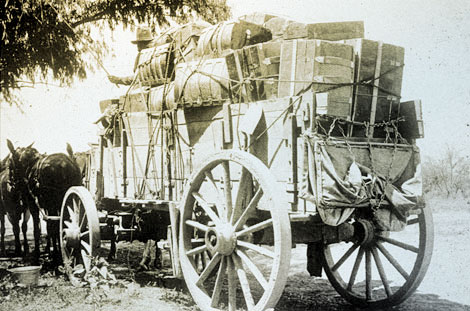 Freight wagon with luggage and baggage belonging to Italian stone masons from Pennsylvania hired to work on construction of the dam, 1906. (Reclamation photograph)
Freight wagon with luggage and baggage belonging to Italian stone masons from Pennsylvania hired to work on construction of the dam, 1906. (Reclamation photograph)
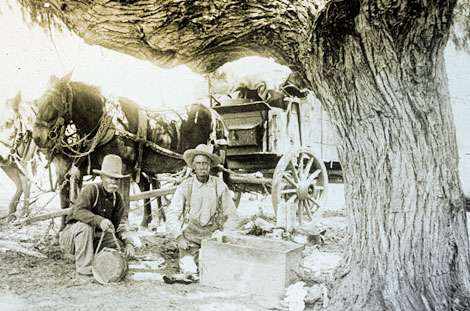 Teamsters preparing lunch at Grapevine Springs en route from Glode to Roosevelt, 1906. (Reclamation photograph)
Teamsters preparing lunch at Grapevine Springs en route from Glode to Roosevelt, 1906. (Reclamation photograph)
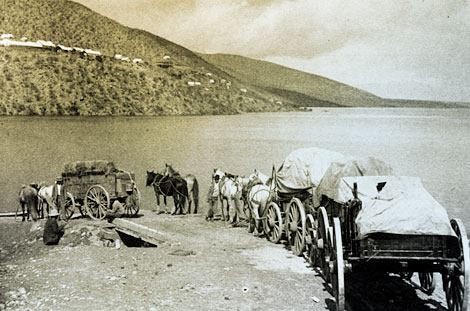 Freight wagons boarding Reclamation Service ferry at Roosevelt, 1910. (Reclamation photograph)
Freight wagons boarding Reclamation Service ferry at Roosevelt, 1910. (Reclamation photograph)
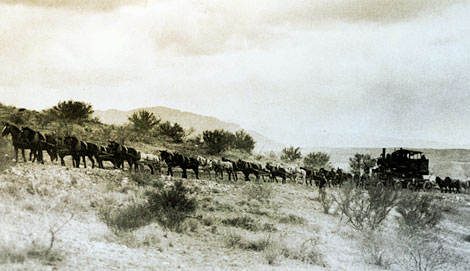 A team of horses and mules pull a small steam locomotive towards the Roosevelt Dam site, No date. (Courtesy of Salt River Project)
A team of horses and mules pull a small steam locomotive towards the Roosevelt Dam site, No date. (Courtesy of Salt River Project)
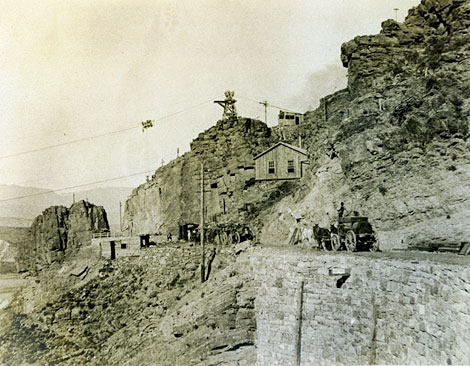 In this photograph, two freight wagons approach the construction site for the Roosevelt Dam, No date. (Courtesy of Salt River Project)
In this photograph, two freight wagons approach the construction site for the Roosevelt Dam, No date. (Courtesy of Salt River Project)
[ Return to Top ]


 View up the Salt River Canyon below the site selected for Roosevelt Dam, 1904. The dam site was identified as early as 1889 by surveyors. (Reclamation photograph)
View up the Salt River Canyon below the site selected for Roosevelt Dam, 1904. The dam site was identified as early as 1889 by surveyors. (Reclamation photograph) The cornerstone for Roosevelt Dam was laid September 20, 1906. (Reclamation photograph)
The cornerstone for Roosevelt Dam was laid September 20, 1906. (Reclamation photograph) As construction got underway, the Reclamation Service established a lumber mill in the Sierra Ancha Mountains north of the Roosevelt Dam site. A local source for construction lumber was less expensive than hauling it from Mesa, 1904. (Reclamation photograph)
As construction got underway, the Reclamation Service established a lumber mill in the Sierra Ancha Mountains north of the Roosevelt Dam site. A local source for construction lumber was less expensive than hauling it from Mesa, 1904. (Reclamation photograph) By 1907, construction of the Roosevelt Dam was well underway. (Reclamation photograph)
By 1907, construction of the Roosevelt Dam was well underway. (Reclamation photograph) Flooding was a serious threat during Roosevelt Dam construction, 1908. (Reclamation photograph)
Flooding was a serious threat during Roosevelt Dam construction, 1908. (Reclamation photograph) Salt River Valley Users Association Meeting as painted by C. Kemper, 1980. L to R: J.kibbey, P.T. Hurley, W. Christy, H. Simkins, W. Wallace, B.A. Fowler, A.J. Chandler, F. Parker, L. Orme, D. Heard, F. Alkire (seated), G. Maxwell. (Courtesy of Salt River Project)
Salt River Valley Users Association Meeting as painted by C. Kemper, 1980. L to R: J.kibbey, P.T. Hurley, W. Christy, H. Simkins, W. Wallace, B.A. Fowler, A.J. Chandler, F. Parker, L. Orme, D. Heard, F. Alkire (seated), G. Maxwell. (Courtesy of Salt River Project) SRP Canals, Courtesy of Salt River Project
SRP Canals, Courtesy of Salt River Project Granite Reef Diversion Dam with outlet for the Arizona Canal around 1910. (Reclamation photograph)
Granite Reef Diversion Dam with outlet for the Arizona Canal around 1910. (Reclamation photograph) Granite Reef Diversion replaced the crude rock and brush dams that washed out in floods, providing a reliable structure to divert water into the Arizona and South canal, 1910. (Reclamation photograph)
Granite Reef Diversion replaced the crude rock and brush dams that washed out in floods, providing a reliable structure to divert water into the Arizona and South canal, 1910. (Reclamation photograph) Canal maintenance was an on-going problem, and Government sheep were used to control weeds and grass along the canals, 1914. (Reclamation photograph)
Canal maintenance was an on-going problem, and Government sheep were used to control weeds and grass along the canals, 1914. (Reclamation photograph) In 1864, the U.S. Army established the Yuma Quartermaster Depot on the Arizona side of the Colorado River where a six-month supply of goods was kept at all times. This is the earliest and one of few photographs of the depot taken before 1871. (Reclamation photograph)
In 1864, the U.S. Army established the Yuma Quartermaster Depot on the Arizona side of the Colorado River where a six-month supply of goods was kept at all times. This is the earliest and one of few photographs of the depot taken before 1871. (Reclamation photograph) U.S. Reclamation Service headquarters, Yuma Project, located at the former Fort Yuma U.S. Army Quartermaster Depot and Yuma Crossing. (Yuma Projects Office Fifth Annual Report, May 26, 1906)
U.S. Reclamation Service headquarters, Yuma Project, located at the former Fort Yuma U.S. Army Quartermaster Depot and Yuma Crossing. (Yuma Projects Office Fifth Annual Report, May 26, 1906) Sketch of the Colorado River Siphon. (National Archives, Yuma Projects Office, No date)
Sketch of the Colorado River Siphon. (National Archives, Yuma Projects Office, No date) View of Laguna Dam showing the desilting basin, sluice gates, and Yuma Canal regulating gates. (National Archives, Yuma Projects Office, No date)
View of Laguna Dam showing the desilting basin, sluice gates, and Yuma Canal regulating gates. (National Archives, Yuma Projects Office, No date) Sand hogs at work on the heading of the Colorado River Siphon tunnel underneath the Colorado River. A "sand hog" is a slang term for construction workers who work underground on a variety of construction projects. A bulkhead of sandbags was built at the end lower of the tunnel while excavation continue in the upper half of the tunnel. The sandbags prevented water from seeping in on the sand hogs while the arch was being drilled, 1912. (National Archives, Yuma Project Office)
Sand hogs at work on the heading of the Colorado River Siphon tunnel underneath the Colorado River. A "sand hog" is a slang term for construction workers who work underground on a variety of construction projects. A bulkhead of sandbags was built at the end lower of the tunnel while excavation continue in the upper half of the tunnel. The sandbags prevented water from seeping in on the sand hogs while the arch was being drilled, 1912. (National Archives, Yuma Project Office) Colorado River Siphon. Looking down 55 feet into the Arizona shaft during the night shift, 1910. (National Archives, Yuma Projects Office)
Colorado River Siphon. Looking down 55 feet into the Arizona shaft during the night shift, 1910. (National Archives, Yuma Projects Office) American Indian laborers were hired by Reclamation Service Chief Engineer Lewis Hill. San Carlos and other Western Apache tribes supplied the bulk of the work force for Roosevelt Dam road construction and other infrastructure needs, 1906. (Reclamation photograph)
American Indian laborers were hired by Reclamation Service Chief Engineer Lewis Hill. San Carlos and other Western Apache tribes supplied the bulk of the work force for Roosevelt Dam road construction and other infrastructure needs, 1906. (Reclamation photograph) Apache workers on the cutoff canal, Roosevelt Dam site, 1909. (Reclamation photograph)
Apache workers on the cutoff canal, Roosevelt Dam site, 1909. (Reclamation photograph) Apache road crew working on the road between Globe and Roosevelt, 1904. (Reclamation photograph)
Apache road crew working on the road between Globe and Roosevelt, 1904. (Reclamation photograph) Apache teamsters placing fill on the new Tonto Highline Road. Note the dry-laid masonry retaining wall. (Reclamation photograph)
Apache teamsters placing fill on the new Tonto Highline Road. Note the dry-laid masonry retaining wall. (Reclamation photograph) Apache workers were known for their skill in building dry-laid stone walls. Without using mortar, they constructed many such retaining walls along the various roads they built. This fine example is on Fish Creek Hill on the Mesa to Roosevelt Road, known today as the Apache Trail, 1905. (Courtesy of Salt River Project)
Apache workers were known for their skill in building dry-laid stone walls. Without using mortar, they constructed many such retaining walls along the various roads they built. This fine example is on Fish Creek Hill on the Mesa to Roosevelt Road, known today as the Apache Trail, 1905. (Courtesy of Salt River Project) Apache workers often brought their families to live with them. They lived in a segregated area and maintained their traditional lifestyle. Here an Apache woman brings firewood to her wickiup, a structure of bent poles covered with brush that is also covered with blankets, tarps, and hides. Note the use of large ceramic storage jars and metal pots and pans, 1911. (Reclamation photograph)
Apache workers often brought their families to live with them. They lived in a segregated area and maintained their traditional lifestyle. Here an Apache woman brings firewood to her wickiup, a structure of bent poles covered with brush that is also covered with blankets, tarps, and hides. Note the use of large ceramic storage jars and metal pots and pans, 1911. (Reclamation photograph) A portion of Mesa to Roosevelt Road at Fish Creek Hill. Note the extensive road work required to cut through the mountain and provide fill for a stable road bed. American Indians, primarily Apaches, constructed over 100 miles of roads to provide access for men, equipment, and supplies to the dam site, 1905. (Reclamation photograph)
A portion of Mesa to Roosevelt Road at Fish Creek Hill. Note the extensive road work required to cut through the mountain and provide fill for a stable road bed. American Indians, primarily Apaches, constructed over 100 miles of roads to provide access for men, equipment, and supplies to the dam site, 1905. (Reclamation photograph) Wagon on road between Mesa and the Roosevelt Dam site, 1904. (Reclamation photograph)
Wagon on road between Mesa and the Roosevelt Dam site, 1904. (Reclamation photograph) Freight wagons with mule team bringing supplies to the Roosevelt Dam site on the road from Globe, 1904. (Reclamation photograph)
Freight wagons with mule team bringing supplies to the Roosevelt Dam site on the road from Globe, 1904. (Reclamation photograph) Government freight wagon at foot of Fish Creek Hill on way to dam site, 1907. (Reclamation photograph)
Government freight wagon at foot of Fish Creek Hill on way to dam site, 1907. (Reclamation photograph) Government freight wagon (previous picture) entering Fish Creek Station, 1907. (Reclamation photograph)
Government freight wagon (previous picture) entering Fish Creek Station, 1907. (Reclamation photograph) Government freight wagon coming up Fish Creek Hill, 1907. (Reclamation photograph)
Government freight wagon coming up Fish Creek Hill, 1907. (Reclamation photograph) Freight wagon with generator headed for Roosevelt Dam from Mesa, 1907. (Reclamation photograph)
Freight wagon with generator headed for Roosevelt Dam from Mesa, 1907. (Reclamation photograph) Freight wagon teams at Government Wells on way to Roosevelt Dam, 1907. (Reclamation photograph)
Freight wagon teams at Government Wells on way to Roosevelt Dam, 1907. (Reclamation photograph) Assisting stage coach on Roosevelt Road, 1910. (Reclamation photograph)
Assisting stage coach on Roosevelt Road, 1910. (Reclamation photograph) Wagon and horses at Government Wells, n.d. (Reclamation photograph)
Wagon and horses at Government Wells, n.d. (Reclamation photograph) Freight wagon with luggage and baggage belonging to Italian stone masons from Pennsylvania hired to work on construction of the dam, 1906. (Reclamation photograph)
Freight wagon with luggage and baggage belonging to Italian stone masons from Pennsylvania hired to work on construction of the dam, 1906. (Reclamation photograph) Teamsters preparing lunch at Grapevine Springs en route from Glode to Roosevelt, 1906. (Reclamation photograph)
Teamsters preparing lunch at Grapevine Springs en route from Glode to Roosevelt, 1906. (Reclamation photograph) Freight wagons boarding Reclamation Service ferry at Roosevelt, 1910. (Reclamation photograph)
Freight wagons boarding Reclamation Service ferry at Roosevelt, 1910. (Reclamation photograph) A team of horses and mules pull a small steam locomotive towards the Roosevelt Dam site, No date. (Courtesy of Salt River Project)
A team of horses and mules pull a small steam locomotive towards the Roosevelt Dam site, No date. (Courtesy of Salt River Project) In this photograph, two freight wagons approach the construction site for the Roosevelt Dam, No date. (Courtesy of Salt River Project)
In this photograph, two freight wagons approach the construction site for the Roosevelt Dam, No date. (Courtesy of Salt River Project)